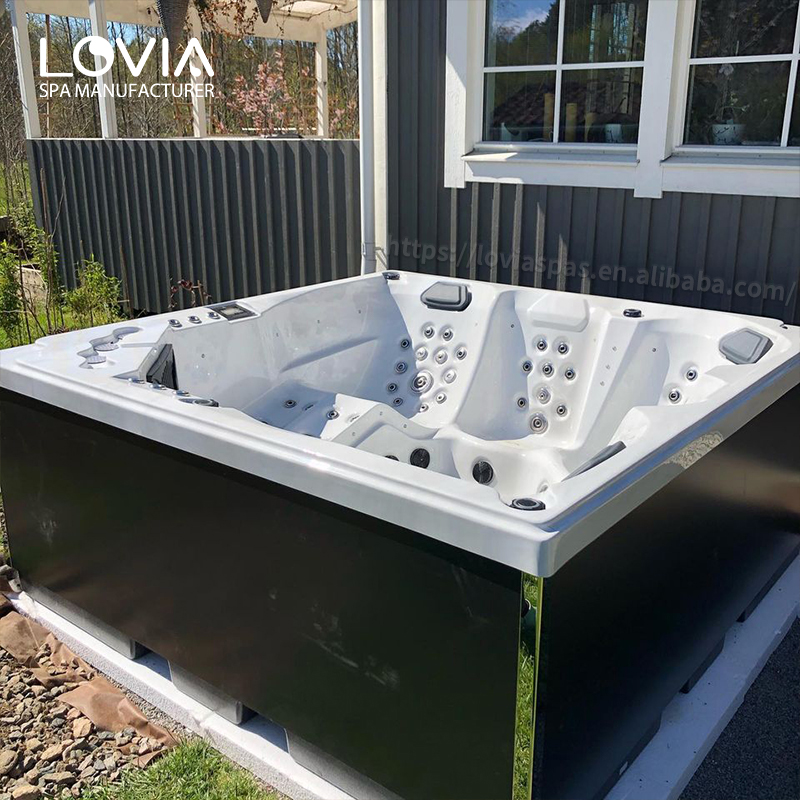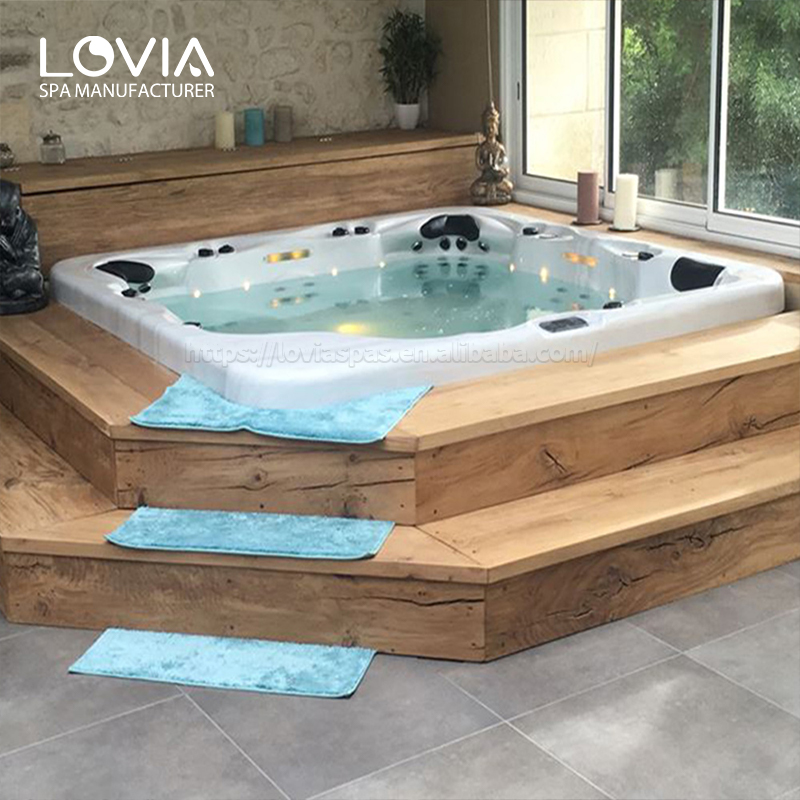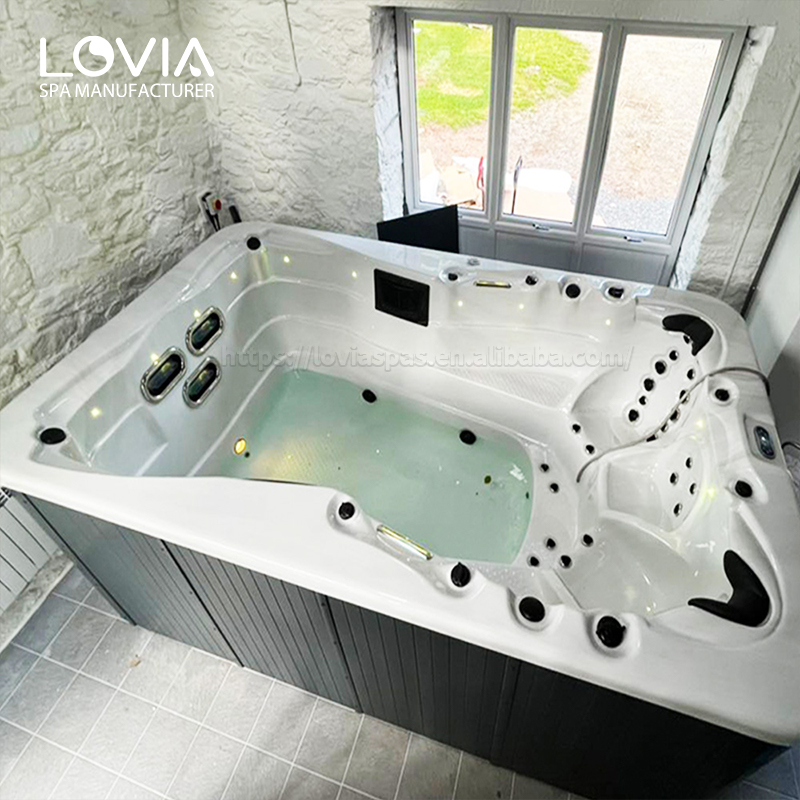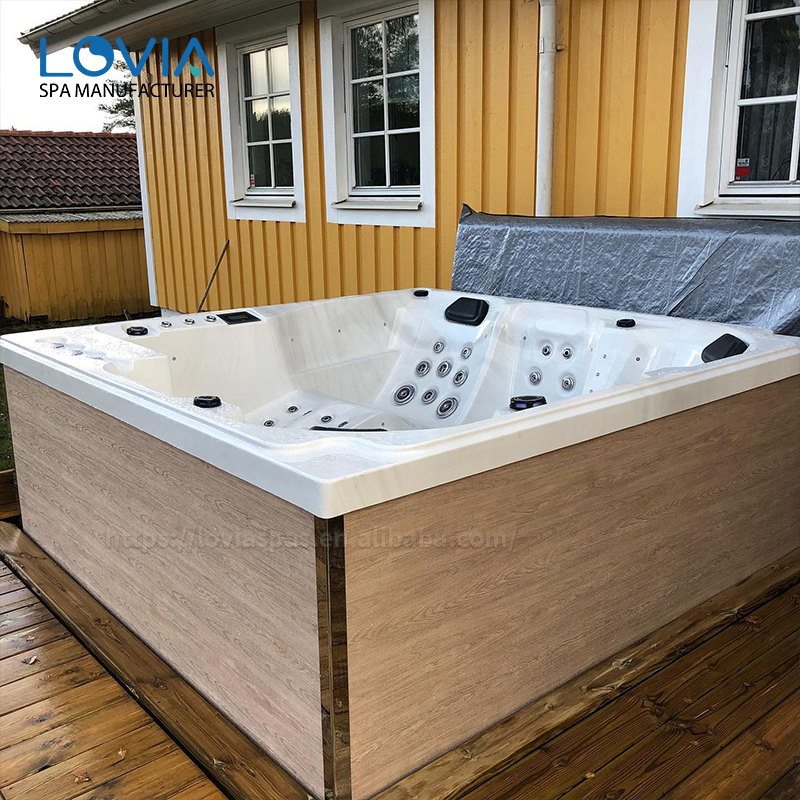
Vad är skillnaden mellan en saltvattensbadtunna och en vanlig badtunna?
2025-07-10 15:30With the rise of a healthy and comfortable lifestyle, hot tubs have become an important part of many people's home environment. However, when choosing a hot tub, buyers often encounter a question: What is the difference between a saltwater hot tub and a regular hot tub? Which one is more suitable for my needs?
This article will deeply analyze the differences between the two types of hot tubs in terms of principles, maintenance, cost, experience, and health effects, helping consumers to more clearly understand their respective advantages and disadvantages, so as to make a wise choice.

What is the basic difference between a saltwater hot tub and a regular hot tub?
1. How does a saltwater hot tub work?
Saltwater hot tubs rely on a device called a saltwater electrolysis system to operate. This system maintains clean water by converting a small amount of salt into chlorine. The core principle is electrolysis, where salt (mainly sodium chloride) is electrolyzed in water to produce chlorine gas, which then dissolves into hypochlorous acid (the main bactericidal ingredient) and other byproducts. This method makes water disinfection more automated while reducing dependence on traditional chlorine chemicals.
2. How Ordinary Hot Tubs Work
Ordinary hot tubs use manually added chemicals (such as chlorine or bromine) to maintain water quality. Users need to regularly monitor and adjust the concentration of chemicals to ensure that the water is clean and does not irritate the skin and eyes. In addition, ordinary hot tubs may require additional water conditioners (such as pH increasers or decreasers) to keep the water balanced.

What are the differences in maintenance between salt water hot tubs and ordinary hot tubs?
1. Maintenance advantages of salt water hot tubs
· Less manual operation: Salt water systems can automatically generate chlorine, reducing the need for frequent addition of disinfectants. Users only need to add salt occasionally.
· More stable water quality: The chlorine concentration produced by the electrolysis process is relatively uniform, and the water quality fluctuates less, reducing irritation problems caused by improper chlorine concentration.
· Longer maintenance cycle: Salt water systems have more efficient filtering and sterilization effects, so they usually require less frequent cleaning and water changes than ordinary hot tubs.
2. Maintenance characteristics of ordinary hot tubs
· Frequent reliance on chemical addition: Ordinary hot tubs require users to manually add chemicals such as chlorine and bromine on a regular basis and test water quality parameters with test strips.
· Prone to chemical imbalance: If not properly operated or monitored, water quality can easily become unbalanced, which may cause skin irritation, odor problems or bacterial growth.
· Higher frequency of water changes: Since there is no automated treatment system, ordinary hot tubs usually need to change water every 3-4 months.

What is the difference in cost between the two?
1. How much does a salt water hot tub cost?
· Initial cost: Salt water hot tubs are generally more expensive than ordinary hot tubs because the installation of salt water electrolysis systems requires additional hardware equipment.
· Long-term operating costs: Although the initial cost is higher, the salt and less chemical consumption required by salt water systems can reduce operating expenses in the long run. In addition, lower maintenance requirements also reduce labor and time costs.
· Equipment maintenance costs: The electrode plates of the salt water electrolysis system need to be replaced regularly (usually every 2-5 years), which is an additional expense.
2. How much does an ordinary hot tub cost?
· Lower initial cost: Ordinary hot tubs do not require additional equipment support, so their purchase cost is lower.
·Higher operating costs: Frequent purchases of chemicals and a higher frequency of water changes make regular hot tubs relatively more expensive to use in the long term.
·High flexibility but dispersed costs: Although the maintenance costs of regular hot tubs are dispersed, the overall cost may be higher than that of salt water systems due to the need to purchase multiple water conditioners on a regular basis.
What are the differences in the health effects of the two systems?
1. Health advantages of salt water hot tubs
·Milder water quality: Salt water systems generally produce lower concentrations of hypochlorous acid, so the water quality is less irritating to the skin and eyes.
·Reduce chemical residues: Bathtubs using salt water systems do not require frequent additions of artificial chemicals, reducing exposure to chemicals.
·Closer to the natural environment: The water quality of salt water bathtubs is similar to natural seawater, so it is considered more suitable for people with sensitive skin.
2、 Potential health risks of regular hot tubs
·Risk of excessive or insufficient chemicals: If the concentration of chlorine or bromine is not adjusted properly, it may cause dry skin, eye irritation, and even respiratory discomfort.
·Chemical accumulation: Long-term use of high-concentration chemicals may cause chemical residues to accumulate inside the bathtub, affecting the health of users.
·Higher risk of bacterial growth: Fluctuations in water quality in ordinary hot tubs may increase the chance of bacterial growth, especially if not properly maintained.

What are the differences in user experience?
1. User experience of salt water hot tubs
·Softer water quality: The water quality of salt water baths is described by many users as softer and closer to nature.
·Reduce pungent odors: Compared with the strong chlorine smell of ordinary bathtubs, salt water bathtubs have a fresher smell.
·No need for frequent operation: The salt water system is highly automated, which reduces the maintenance burden for users.
2. User experience of ordinary hot tubs
·Higher controllability: Users can quickly adjust the concentration of chemicals as needed to cope with different usage frequencies and needs.
·Odors may be generated during operation: Strong odors may be generated after adding chemicals, affecting the experience.
·More obvious changes in water quality: The water quality changes to a large extent and requires more detailed management.
Are salt water hot tubs more environmentally friendly?
Because salt water baths reduce the use of artificial chemicals and their water quality is easier to decompose naturally, they are generally considered a more environmentally friendly option. However, this advantage needs to be balanced with the energy and material consumption of its electrolysis equipment. In contrast, the environmental impact of ordinary hot tubs mainly comes from the production of chemicals and the treatment of wastewater.
Can you accommodate small orders?
Definitely. Lovia Spa is flexible and welcomes orders of any size—from single units for showrooms to large wholesale shipments. With our strong production scale, we can integrate small orders easily, while still offering competitive pricing, discounts, and quotes. Small clients benefit from high-quality products and the same CE, ETL, SAA, RoHS, REACH, and ISO9001 certifications as our bulk clients. We're dedicated to building long-term relationships with every buyer.
